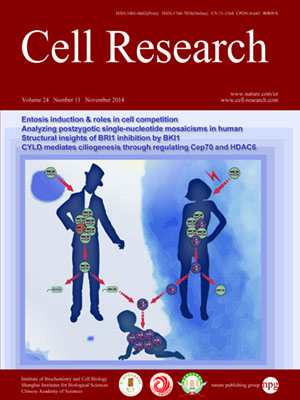
Volume 24, No 11, Nov 2014
ISSN: 1001-0602
EISSN: 1748-7838 2018
impact factor 17.848*
(Clarivate Analytics, 2019)
Volume 24 Issue 11, November 2014: 1299-1310
ORIGINAL ARTICLES
Competition between human cells by entosis
Qiang Sun1,2, Tianzhi Luo3, Yixin Ren3, Oliver Florey4, Senji Shirasawa5, Takehiko Sasazuki6, Douglas N Robinson3 and Michael Overholtzer2,7
1Laboratory of Cell Engineering, Institute of Biotechnology, Beijing 100071, China
2Cell Biology Program, Memorial Sloan-Kettering Cancer Center, New York, NY 10065, USA
3Department of Cell Biology, Johns Hopkins University School of Medicine, Baltimore, MD 21205, USA
4Signalling Programme, The Babraham Institute, Cambridge, CB22 3AT, UK
5Department of Cell Biology, School of Medicine, Fukuoka University, Fukuoka 814-0180, Japan
6Department of Pathology, Research Institute, International Medical Center of Japan, Tokyo 163-8655, Japan
7BCMB Allied Program, Weill Cornell Medical College, 1300 York Avenue, New York, NY 10065, USA
Correspondence: Michael Overholtzer, Tel: +1-212-639-6536; Fax: +1-212-794-4342 E-mail: overhom1@mskcc.org; Qiang Sun, Tel: +86-10-66948820(sunqiang1975@126.com)
Human carcinomas are comprised of complex mixtures of tumor cells that are known to compete indirectly for nutrients and growth factors. Whether tumor cells could also compete directly, for example by elimination of rivals, is not known. Here we show that human cells can directly compete by a mechanism of engulfment called entosis. By entosis, cells are engulfed, or cannibalized while alive, and subsequently undergo cell death. We find that the identity of engulfing (“winner”) and engulfed (“loser”) cells is dictated by mechanical deformability controlled by RhoA and actomyosin, where tumor cells with high deformability preferentially engulf and outcompete neighboring cells with low deformability in heterogeneous populations. We further find that activated Kras and Rac signaling impart winner status to cells by downregulating contractile myosin, allowing for the internalization of neighboring cells that eventually undergo cell death. Finally, we compute the energy landscape of cell-in-cell formation, demonstrating that a mechanical differential between winner and loser cells is required for entosis to proceed. These data define a mechanism of competition in mammalian cells that occurs in human tumors.
10.1038/cr.2014.138
FULL TEXT | PDF
Browse 2458


